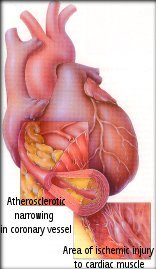Big C Discount Drugs Health Information
Angina Pectoris
Chest Pain Is a Sign
 Angina is a term for chest pain. It develops when the heart does not get as much oxygen as it needs, a condition known as myocardial (heart muscle) ischemia (without oxygen). Angina is commonly a sign of coronary artery disease, in which the arteries that supply blood to the heart muscle are narrowed or blocked. Angina is more likely to occur when the work of the heart is increased, such as during exercise, extreme heat or cold, or during strong emotional stress. If pain occurs at rest, when the work of the heart is not increased, the condition is called Prinzmetal's or variant angina. The pain of angina can spread to the jaw, teeth or between the shoulder blades. A squeezing feeling or tightness in the chest is also commonly felt. Angina is a symptom of temporary myocardial ischemia; it is also a sign that someone is at higher risk of a heart attack. Angina can often be prevented with medication. An acute attack of angina is treated with rest and nitroglycerin tablets dissolved under the tongue.
Angina is a term for chest pain. It develops when the heart does not get as much oxygen as it needs, a condition known as myocardial (heart muscle) ischemia (without oxygen). Angina is commonly a sign of coronary artery disease, in which the arteries that supply blood to the heart muscle are narrowed or blocked. Angina is more likely to occur when the work of the heart is increased, such as during exercise, extreme heat or cold, or during strong emotional stress. If pain occurs at rest, when the work of the heart is not increased, the condition is called Prinzmetal's or variant angina. The pain of angina can spread to the jaw, teeth or between the shoulder blades. A squeezing feeling or tightness in the chest is also commonly felt. Angina is a symptom of temporary myocardial ischemia; it is also a sign that someone is at higher risk of a heart attack. Angina can often be prevented with medication. An acute attack of angina is treated with rest and nitroglycerin tablets dissolved under the tongue.A Symptom of Heart Disease
Angina (chest pain) is a result of too little oxygen reaching the heart muscle. This could be due to a spasm or a blockage of an artery carrying oxygen-rich blood. Angina is a common symptom of coronary heart disease, a narrowing or blockage of coronary (heart) blood vessels. In most people, an attack of angina only occurs when the demands on the heart muscle are high, such as during stress, exercise, cigarette smoking, consumption of alcohol, heavy meals, or with extreme temperature changes. Angina is not a heart attack; it is a temporary shortage of oxygen to the heart muscle. However, angina is a risk factor for heart attack. A heart attack occurs when a shortage of oxygen to the heart is prolonged, causing permanent damage to a part of the heart muscle.Types of Angina: Typical or stable angina is the most common type of angina. The chest pain of stable angina starts slowly, and usually lasts only a few minutes. It may occur as a tightness or heaviness in the chest area, or it may be a true pain sensation. The pain often starts under the left breastbone, and may feel like the burning pain of indigestion. Angina pain may also spread to the back, neck, jaw, shoulders, or left arm. Sometimes there is a numbness, tingling or aching feeling in the arm or shoulder. Unstable angina includes any chest pain that doesn't follow the pattern of stable angina. This type of angina does not start gradually, but may begin as a very severe chest pain. Unstable angina may also occur at rest. This angina pattern is dangerous, perhaps signaling a heart attack. A rare type of angina, Prinzmetal's variant, occurs when spasms in the arteries supplying the heart with oxygen make it difficult for the blood to reach the heart muscle. This type of angina usually occurs at rest, often during sleep.
Risk Factors: Risk factors for developing angina include high blood pressure, high cholesterol, obesity, diabetes, and cigarette smoking. People with a family history of coronary artery disease may also be at higher risk. Changes in lifestyle are very effective in avoiding angina. Good eating habits lead to lower cholesterol and correct weight. Large meals rich in fatty foods should be avoided, alcohol intake should be moderate, and smoking is forbidden. Moderate exercise is also important for staying in shape; intense exercise should be avoided.
Diagnosis and Treatment: A diagnosis of angina is confirmed by an electrocardiogram (ECG), stress test, and cardiac catheterization (a special x-ray of the heart). Sometimes, a trial of nitroglycerin is used to see if it relieves the pain. Treatment includes nitroglycerin dissolved under the tongue for an acute attack of chest pain, or medications taken every day to avoid the angina attack. Nitroglycerin, which can relieve the pain in seconds, lightens the work of the heart muscle and allows better blood flow to the heart during an attack. Drugs to prevent angina include aspirin, beta-blockers, nitrates, and calcium channel blockers. These drugs must be taken daily, even if no symptoms are present. They should never be stopped without instructions from your doctor. If drugs and lifestyle changes are not effective in controlling angina, or if angina pain changes or worsens, other treatment includes angioplasty or cardiac bypass surgery. If angina is not properly treated, it can lead to complications such as a heart attack, abnormal heart rhythms, or even cardiac arrest. If you have symptoms, see your doctor.
See also Angina Pectoris 2
